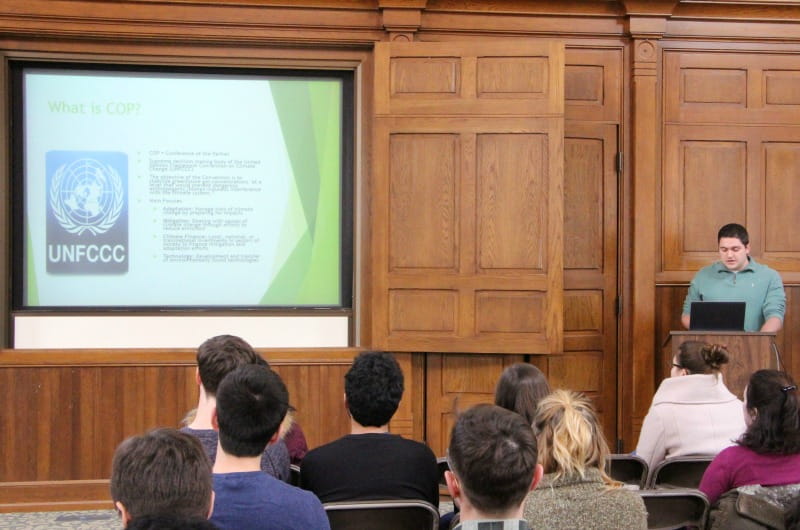Climate Change Workshop Tackles Solutions to a Global Problem
 By Ben Seal
By Ben Seal

Drexel graduate student Dalton George presents findings from COP22, the global climate change conference that took place in November.
There may be more hurdles to environmental progress in the United States today than in the immediate past, but the Drexel students and faculty involved in the climate action movement expect the global fight to carry on apace. The cohort who attended November’s climate change conference in Morocco, sponsored by the Office of International Programs and the Institute for Energy and the Environment, presented their findings Jan. 30 in the Paul Peck Alumni Center and led a discussion about how the Drexel community can take action to support the environment on an individual and institutional basis.
The 22nd Conference of the Parties of the United Nations Framework Convention on Climate Change, or COP22, which five students and five faculty members attended, focused on implementation of the landmark Paris agreement reached the year before to curtail the damage humans are doing to the environment. Franco Montalto, PhD, the director of the North American Hub of the Urban Climate Change Research Network at Drexel and an associate professor in the College of Engineering, gave a brief overview of the extent of that damage to set the stage for the afternoon’s presentations. In a series of startling charts and graphs showing the stark changes in greenhouse gas emissions and global warming in recent years, he set up a simple question.
“What now?” Montalto asked. “What can different nations do?”
There are no silver bullets, according to Carol Collier, director of Drexel’s Environmental Studies and Sustainability Program, but there is reason for optimism. She told the audience, which included a few dozen students, that the push toward action in Morocco left her hopeful. Despite the steep hill to climb to limit global warming, efforts in the areas of reforestation, climate-smart soils and water resources all offer paths to progress.
Much of the change in America is likely to come from cities, Hugh Johnson, a senior associate in the Institute for Energy and the Environment, said. About 70 percent of American emissions come from cities, leaving plenty of opportunity for focused efforts to make incremental progress, he said. For those fearing that the new administration’s apparent distrust of climate science will set the country back, he suggested Canada’s recent experience as a point of comparison. Hundreds of government scientists were fired under former Prime Minister Stephen Harper and government discussion of climate change was banned; cities nonetheless continued to move forward to find new solutions on their own.
Johnson also said the business case for environmental progress is clear. Companies including Google, Facebook, Goldman Sachs and Apple are leading the march toward renewable energy, he said. Like Collier, he was optimistic about what he saw at COP22.
“It was right after the election and there was no backing down,” said Johnson.
Eugenia Victoria Ellis, PhD, director of the dLUX light lab and an associate professor in the College of Engineering and the Westphal College of Media Arts & Design, focused her portion of the presentation on the role of the built environment — everything humans have created, invented and constructed to facilitate living on Earth — in climate change. Nearly half of the energy consumption in the United States comes from buildings, including three-quarters of the electricity used. In terms of per capita emissions, the United States is twice as harmful to the environment as China and three times as harmful as any other country. “We’re the worst offenders worldwide,” she said. The built environment, though, presents many opportunities for change in an effort to meet the goal of limiting global warming to 2°C in the coming decades.
“If we look at buildings as a whole and we want to reduce their energy consumption to meet 2°C goals, this can be done by using low-energy lighting and designing the building envelope to reduce heating and cooling needs,” said Ellis.
Following the presentations, the students who attended COP22 split the crowd into four groups to discuss plans for action. The conversations focused on how Drexel can divest from fossil fuels, opportunities for local activism, ways to encourage state representatives to take action and how to become more climate-friendly on a personal level. Those in attendance walked away with new ideas and a mind for action, much like the students and faculty at the conference in Morocco.
“It was an extremely valuable addition to our development, not only as students but as citizens of the United States,” said Dalton George, a COP22 attendee and a graduate student in the Center of Science, Technology and Society.
The Office of International Programs will be seeking applicants in the summer for faculty, staff and students who would like to attend COP23 and continue Drexel’s participation in the conference.
Drexel News is produced by
University Marketing and Communications.
